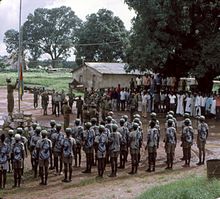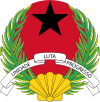Flag of Guinea-Bissau: Difference between revisions
Tags: Mobile edit Mobile web edit Advanced mobile edit |
Pescavelho (talk | contribs) Table implies that there are standardized colors. If this is the case, the documents laying out such standardization should be cited in this section. If there are no standardized colors, this should be noted in the article and the table removed. |
||
| (20 intermediate revisions by 17 users not shown) | |||
| Line 1: | Line 1: | ||
{{short description|National flag}} |
{{short description|National flag}} |
||
{{Infobox flag |
{{Infobox flag |
||
| Name = Guinea-Bissau |
| Name = Republic of Guinea-Bissau |
||
| Article = the |
|||
| Image = Flag of Guinea-Bissau.svg |
| Image = Flag of Guinea-Bissau.svg |
||
| Noborder = |
| Noborder = |
||
| Line 8: | Line 7: | ||
| Morenicks = |
| Morenicks = |
||
| Use = 111111 |
| Use = 111111 |
||
| Symbol = {{FIAV|111111}} {{FIAV|normal}} {{FIAV|Mirror}} |
|||
| Symbol = |
|||
| Proportion = 1:2 |
| Proportion = 1:2 |
||
| Adoption = {{start date|1973|09|24}} |
| Adoption = {{start date and age|1973|09|24|df=y}}<br>(de facto)<br>{{start date and age|1974|09|10|df=y}}<br>(de jure) |
||
| Design = One vertical red line on the [[hoist (flag)|hoist side]] charged with a black five-pointed star; two horizontal lines on the [[fly (flag)|fly side]] (yellow and green) |
| Design = One vertical red line on the [[hoist (flag)|hoist side]] charged with a black five-pointed star; two horizontal lines on the [[fly (flag)|fly side]] (yellow and green) |
||
| Designer = |
| Designer = |
||
}} |
}} |
||
[[File:Stamp Amílcar Cabral.jpg|thumb|[[Deutsche Post of the GDR|East German stamp]] with portrait of [[Amílcar Cabral]] and the Guinea-Bissau flag]] |
|||
The [[national flag|national]] '''flag of Guinea-Bissau''' was adopted in 1973 when independence from [[Portugal]] was proclaimed. |
The [[national flag|national]] '''flag of Guinea-Bissau''' was adopted in 1973 when independence from [[Portugal]] was proclaimed. |
||
==Gallery== |
==Gallery== |
||
<gallery> |
<gallery> |
||
File: |
File:Proposed flag of Portuguese Guinea (1932).svg|{{FIAV|proposal}} Proposed flag for the [[Portuguese Guinea]] (1932) |
||
File:Flag of Portugal.svg|[[Flag of Portugal|Flag]] of [[Portuguese Guinea]]<br>(1911–1973 (''[[de facto]]'')/1974 (''[[de jure]]'')) |
|||
File:Flag of Portuguese Guinea (proposal).svg|{{FIAV|proposal}} Proposed flag for the [[Portuguese Guinea]] (1965) |
|||
File:Flag of PAIGC.svg|Flag of PAIGC |
File:Flag of PAIGC.svg|Flag of PAIGC |
||
Military flag of Guinea-Bissau.svg|Flag of the Armed Forces |
|||
File:Roundel_of_Guinea-Bissau.svg|Roundel of Guinea-Bissau |
|||
</gallery> |
</gallery> |
||
{{Infobox flag |
|||
| Name = Portuguese Guinea |
|||
| Image = File:Flag of Portugal.svg |
|||
| Nickname = ''Bandeira das Quinas'' (Flag of the Five Escutcheons) |
|||
| Morenicks = ''Bandeira Verde-Rubra'' (Green-Red Flag) |
|||
| Use = 111111 |
|||
| Proportion = 2:3 |
|||
| Adoption = 30 June 1911 |
|||
| Relinquished = 23 September 1973 (''[[de jure]]'')<br>10 September 1974 (''[[de facto]]'') |
|||
| Design = A 2:3 vertically striped bicolour of [[green]] and [[red]], with the lesser [[coat of arms of Portugal]] centred over the colour boundary |
|||
| Use2 = 001000 |
|||
| Proportion2 = 12:13 |
|||
| Design2 = As above, but evenly striped (1:1) and with the greater coat of arms, displaying a white scroll with the motto ''"Esta é a ditosa pátria minha amada"'' ("This is my beloved blissful homeland"), taken from [[Os Lusíadas]], III, 21, v. 1 |
|||
| Type = National |
|||
}} |
|||
== Design == |
== Design == |
||
[[File:Hastear da bandeira da Guiné Bissau após o arrear da de Portugal.jpg|thumb|[[Canjadude]], 1974: Running up the Guinea-Bissau flag after [[Striking the colors|striking]] the Portuguese flag]] |
|||
Like the former [[flag of Cape Verde]], the flag is based on that of the [[African Party for the Independence of Guinea and Cape Verde]] (PAIGC). The party was established in 1956 to peacefully campaign for independence from [[Portugal]] during its [[Estado Novo (Portugal)|Estado Novo]] regime, but turned to armed conflict in the 1960s and was one of the belligerents in the 1963–74 [[Guinea-Bissau War of Independence]]. It is still the dominant party in Guinea-Bissau. The PAIGC party flag was derived from [[Flag of Ghana|that of Ghana]], which was the first design to use the Pan-African combination of red, yellow, green, and black in 1957. |
Like the former [[flag of Cape Verde]], the flag is based on that of the [[African Party for the Independence of Guinea and Cape Verde]] (PAIGC). The party was established in 1956 to peacefully campaign for independence from [[Portugal]] during its [[Estado Novo (Portugal)|Estado Novo]] regime, but turned to armed conflict in the 1960s and was one of the belligerents in the 1963–74 [[Guinea-Bissau War of Independence]]. It is still the dominant party in Guinea-Bissau. The PAIGC party flag was derived from [[Flag of Ghana|that of Ghana]], which was the first design to use the Pan-African combination of red, yellow, green, and black in 1957.{{citation needed|date=May 2021}} |
||
In the Ghanaian view, the black star stands for the unity of Africa. Red stands for the blood shed during the struggle for independence, yellow stands for the sun, and green represents hope. |
In the Ghanaian view, the black star stands for the unity of Africa. Red stands for the blood shed during the struggle for independence, yellow stands for the sun, and green represents hope.{{citation needed|date=May 2021}} |
||
The flag features the traditional [[Pan-African]] colors of gold, green, red, and also the [[Black Star of Africa]]. The flag's design is heavily influenced by the [[flag of Ghana]]. The colors have the same meanings: specifically, the red is for the blood of martyrs, green for forests, and gold for mineral wealth. |
The flag features the traditional [[Pan-African]] colors of gold, green, red, and also the [[Black Star of Africa]]. The flag's design is heavily influenced by the [[flag of Ghana]]. The colors have the same meanings: specifically, the red is for the blood of martyrs, green for forests, and gold for mineral wealth.{{citation needed|date=May 2021}} |
||
==Colors== |
==Colors== |
||
{{Unreferenced section|date=June 2024}} |
|||
{| class="wikitable" width="600px" border="1" cellpadding="2" cellspacing="0" style="background: #f9f9f9; border: 1px solid #aaaaaa; border-collapse: collapse; white-space: nowrap; text-align: left" |
{| class="wikitable" width="600px" border="1" cellpadding="2" cellspacing="0" style="background: #f9f9f9; border: 1px solid #aaaaaa; border-collapse: collapse; white-space: nowrap; text-align: left" |
||
|- style="text-align: center; background: #eee" |
|- style="text-align: center; background: #eee" |
||
| Line 54: | Line 42: | ||
!style="background:#CE1126; color:#FFF; width:150px"| Red |
!style="background:#CE1126; color:#FFF; width:150px"| Red |
||
!style="background:#FCD116; color:#000; width:150px"| Yellow |
!style="background:#FCD116; color:#000; width:150px"| Yellow |
||
!style="background:#009E49; color:# |
!style="background:#009E49; color:#FFF; width:150px"| Green |
||
width:150px"| Green |
|||
|- |
|- |
||
| [[Pantone]] |
| [[Pantone]] |
||
| Line 90: | Line 77: | ||
{{clear}} |
{{clear}} |
||
== See also == |
|||
* [[Pan-African colours|Pan-African colors]] |
|||
* [[Flag of Texas]] |
|||
{{Guinea-Bissau topics}} |
{{Guinea-Bissau topics}} |
||
{{Africa topic|Flag of|title=[[Flags of Africa]]}} |
{{Africa topic|Flag of|title=[[Flags of Africa]]}} |
||
Revision as of 22:13, 17 June 2024
 | |
| Use | National flag and ensign |
|---|---|
| Proportion | 1:2 |
| Adopted | 24 September 1973 (de facto) 10 September 1974 (de jure) |
| Design | One vertical red line on the hoist side charged with a black five-pointed star; two horizontal lines on the fly side (yellow and green) |

The national flag of Guinea-Bissau was adopted in 1973 when independence from Portugal was proclaimed.
Gallery
-
 Proposed flag for the Portuguese Guinea (1932)
Proposed flag for the Portuguese Guinea (1932) -
 Proposed flag for the Portuguese Guinea (1965)
Proposed flag for the Portuguese Guinea (1965) -
Flag of PAIGC
-
Flag of the Armed Forces
-
Roundel of Guinea-Bissau
Design

Like the former flag of Cape Verde, the flag is based on that of the African Party for the Independence of Guinea and Cape Verde (PAIGC). The party was established in 1956 to peacefully campaign for independence from Portugal during its Estado Novo regime, but turned to armed conflict in the 1960s and was one of the belligerents in the 1963–74 Guinea-Bissau War of Independence. It is still the dominant party in Guinea-Bissau. The PAIGC party flag was derived from that of Ghana, which was the first design to use the Pan-African combination of red, yellow, green, and black in 1957.[citation needed]
In the Ghanaian view, the black star stands for the unity of Africa. Red stands for the blood shed during the struggle for independence, yellow stands for the sun, and green represents hope.[citation needed]
The flag features the traditional Pan-African colors of gold, green, red, and also the Black Star of Africa. The flag's design is heavily influenced by the flag of Ghana. The colors have the same meanings: specifically, the red is for the blood of martyrs, green for forests, and gold for mineral wealth.[citation needed]
Colors
(1973–present) |
Black | Red | Yellow | Green |
|---|---|---|---|---|
| Pantone | Black c | 032c | 109c | 355c |
| CMYK | 0-0-0-1 | 0-0.92-0.82-0.19 | 0-0.17-0.91-0.01 | 1-0-0.54-0.38 |
| RGB | 0-0-0 | 206-17-38 | 252-209-22 | 0-158-73 |
| Hexadecimal | #000000 | #CE1126 | #FCD116 | #009E49 |
References
This section needs expansion. You can help by adding to it. (June 2016) |







